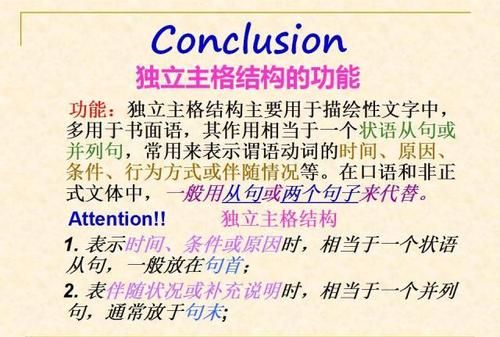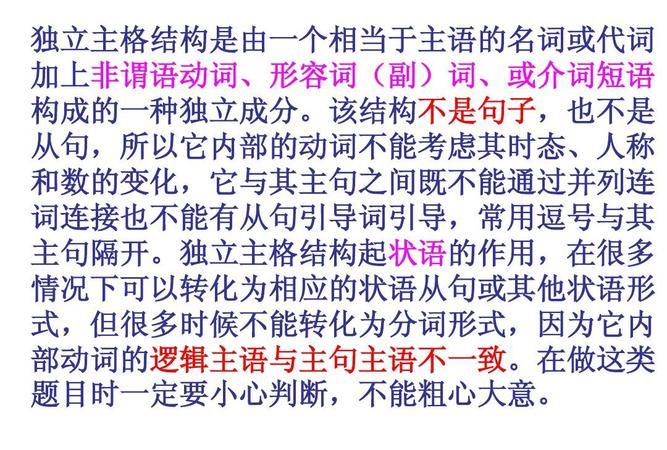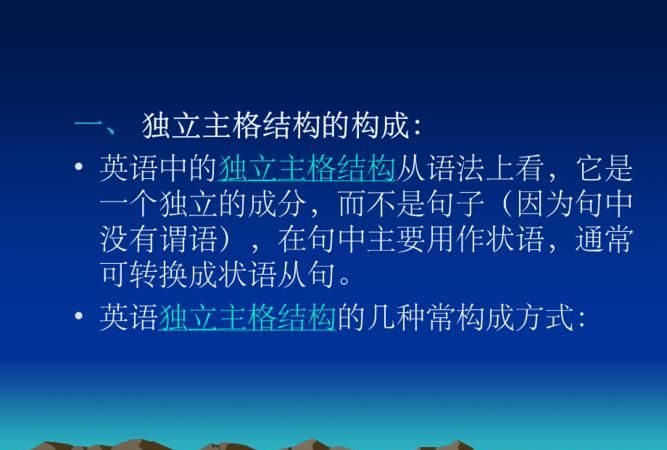本文目录

分词独立结构的用法
独立主格
由一个名词或代词作为逻辑主语,加上一个分词、形容词、副词、动词不定式或介词短语作为逻辑谓语构成,这种结构在形式上与主句没有关系,通常被称为独立主格结构。
(一)独立主格结构的构成:
名词(代词)+现在分词、过去分词
名词(代词)+形容词
名词(代词)+副词
名词(代词)+不定式
名词(代词) +介词短语构成
独立主格结构主要起状语作用,相当于一个状语从句,多用来表示行为、方式、伴随等情况,有时也可用来表示时间、原因、条件等情况。
1、名词或代词主格 + 分词
①The experiment done, the students went on to take notes in the experiment report.
实验做完了,同学们继续在实验报告上做记录。
②Time permitting, we can have a walk around the playground after supper.
如果时间允许,晚饭后我们可以到操场上散步。
2、名词或代词主格 + 形容词
①Computers very small, we can use them widely. 电脑虽小,我们却能广泛地利用它们。
② The clothes very dirty, you'd better wash them quickly. 衣服很脏,你快点儿洗洗吧!
3、名词或代词主格 + 不定式
The last guest to arrive, our party was started. 最后一位客人到了,我们的晚会就开始了。
4、名词或代词主格 + 介词短语
① Our English teacher came into the classroom, papers in hand.
我们的英语老师走进了教室,手里拿着试卷。
② There is a river in the valley, fresh flowers on the banks.
山谷中有一条河,河两岸长满了鲜花。
5、名词或代词主格 + 副词
① The meeting over, our headmaster soon left the meeting-room. 散会了,校长很快就离开了会议室。
② The lights off, we could not go on with the work. 灯熄了,我们不能继续工作了。

独立主格的用法
独立主格结构是一个独立主格的名词或代词(作为逻辑主格),加上一个分词、形容词、副词、不定式、介词短语。其作用相当于状语,多用来表示行为、方式或伴随的情况,有时也用来表示时间和条件。这种结构多用在书面语中。
一、几种常见的独立主格结构形式
1.名词(或代词)+现在分词(或过去分词)。如:
1)The moon appearing,they decided to go on with theirjouney.
2)Good-bye said,he went home.
2.名词(或代词)+形容词。如:
3)The weather(being)hot,we all went swimming.
3.名词(或代词)+不定式。如:
4)Some of the money to be paid by the thief, the policewent.
4.名词(或代词)+介词短语。如:
5)He climbed in,sword in hand.
5.名词(或代词)+副词。如:
6)The meeting(being)over, we left the room.
独立主格结构的模式是:
主格名词/代词 + 分词/形容词/副词/不定式/介词短语
(作逻辑主语) (作逻辑谓语)
1. All our savings gone, we started looking for jobs.
2. The question settled, we went home.
3. The river having risen in the night, the crossing was impossible.
主格名词/代词 + 分词 (过去分词/现在分词)
主格名词/代词 + 形容词
1. His mother being ill, he had to stay home to look after her.
2. Other things being equal, I would buy the black dress.
主格名词/代词 + 副词
The meeting being over, our headmaster soon left
the meeting-room.
We to care for the children, you are able to be carefree
away from home.
主格名词/代词 + 不定式
主格名词/代词 +介词短语
Our English teacher came into the classroom, papers in hand.
with复合结构 与 独立主格结构
它们都可以在句中作原因状语,伴随状况状语,条件状语,时间状语或结果状语用,一般也可以相互转换.虽然它们的语法功能和意义相同,但其结构形式和名称却不相同.
with复合结构的模式是:
with+名词/代词+分词/形容词/副词/不定式/介词短语
独立主格结构的模式是:
主格名词/代词+分词/形容词/副词/不定式/介词短语
一,作时间状语
1,With winter coming on, the trees turn yellow and
some birds fly south.
=Winter coming on, the trees turn yellow and some
birds fly south.
二,作原因状语
1,With the weather terribly cold, we entered the
room to warm ourselves.
= The weather terribly cold, we entered the room to warm ourselves.
2,With the key having been lost, she could not
enter the room.
= The key having been lost, she could not enter the room.
三,作条件状语
1,With time permitting, we'll visit the Summer Palace.
= Time permitting, we'll visit the Summer Palace.
2,With the car going wrong, we'll have to stop
at the foot of the mountain.
= The car going wrong, we'll have to stop at the foot
of the mountain.
四,作伴随状语
1,The mother was cleaning the house with her baby
playing on the bed.
=The mother was cleaning the house, her baby playing
on the bed.
2,Last night I followed him, with a sword in my hand.
= Last night I followed him , sword in hand.
无论with复合结构还是独立主格结构,都不可有动词的谓语形式充当其中的逻辑谓语.如下例中的was就必须去掉:
He sat at the desk reading
with a pen was in his right hand.
with复合结构可以作后置定语修饰名词,而独立主格结构则不可作后置定语修饰名词.
Soon she arrived at a park with grass green and
flowers in blossom.
= Soon she arrived at a park whose grass was green
and whose flowers were in blossom.

独立主格结构怎么用到作文中呢?
独立主格结构的用法
独立主格结构是一个名词或代词(作为逻辑主语),加上一个形容词、副词、介词短语、分词、不定式、名词等构成,在句中常作状语。
一、独立主格结构的特点
1、独立主格结构的逻辑主语与句子主语不同,它独立存在。
2、名词或代词与后面的形容词、副词、介词短语、分词、不定式等存在逻辑上的主谓关系。
3、独立主格结构一般是用逗号与主句分开,但与主句之间不能使用任何连接词。
二、独立主格结构的构成
1、名词或代词 + 现在分词
The children playing in the room, I couldn’t get down studying.
孩子们在屋里玩,我没法学习。

以上就是关于独立主格结构分词的用法 ,独立主格与分词的独立结构用法完全一样的全部内容,以及独立主格结构分词的用法 的相关内容,希望能够帮到您。

